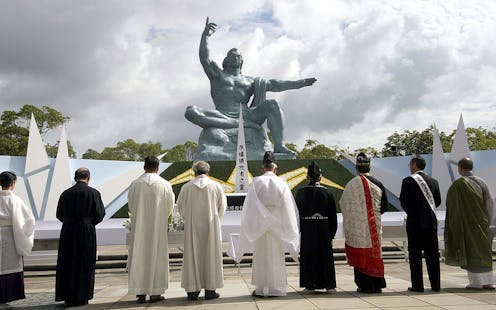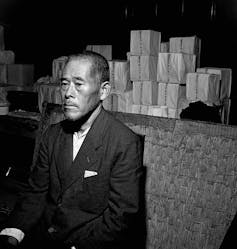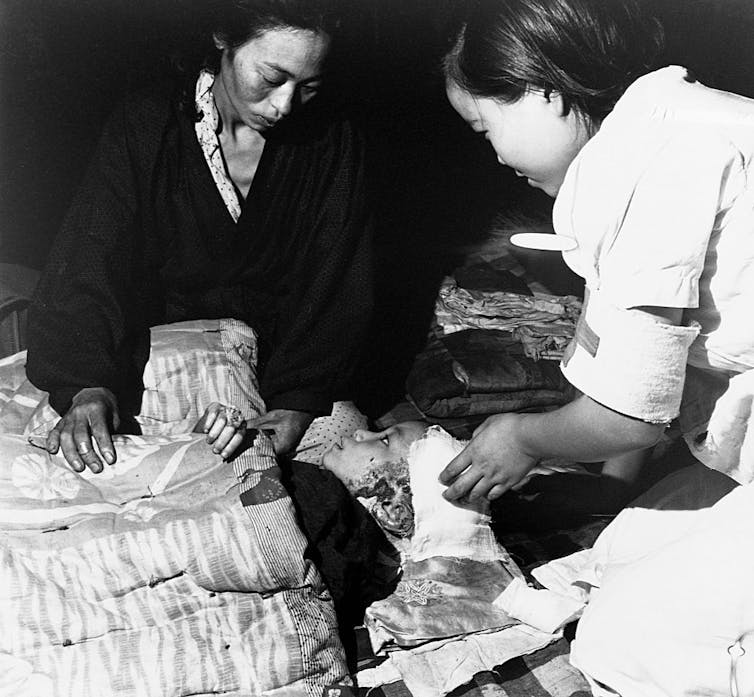
It has been over seven decades since the atomic bombs were dropped on Hiroshima and Nagasaki on Aug. 6 and Aug. 9, 1945. The U.S. attack left between 110,000 and 220,000 people dead, and hundreds of thousands more who survived the bomb but suffered its effects – people known in Japan as “hibakusha,” many of whom died of related illnesses.
Yet the production and possession of nuclear weapons has not stopped. In the United States, they hold an important place in the national psyche, regarded as ultimate protection.
For years, hibakusha have shared their testimonies and memories with the public. However, as an ethicist working on nuclear discourses in the U.S. and Japan, I have been frustrated to see that their philosophical, religious and spiritual perspectives on the matter are largely overlooked in English-language literature. Popular culture seems to value their tragic stories, but not their struggle to come to terms with the event.
Religious leaders’ understandings, rooted in their own experiences living in post-atomic Hiroshima and Nagasaki, offer insights into our violent world. At times, their interpretations of the bombings have been used to promote political agendas. Nonetheless, their interpretations allow people today to reconsider the ethics of responsibility in the atomic age.
Punishment from above
Hiroshima, where the first of the two bombs was dropped in Japan, has historically been known for the True Pure Land school of Buddhism, or Shin Buddhism, the largest Buddhist institution in Japan. Its Hiroshima adherents are called “aki monto.”
One of them was Kōji Shigenobu, who grew up to become a Shin Buddhist priest. He and other schoolchildren had been evacuated from the city during the war but lost family members in the inferno. Eventually, he developed a perspective on the bombing that represented many Hiroshima residents’ frame of mind, as I describe in my book “Beyond the Mushroom Cloud.”

In his essay, Kōji viewed the atomic bombing as representing three circles of sins: the sins of Hiroshima residents, of Japanese nationals and of humanity as a whole. He failed to mention that the city was one of Japan’s military bases sending soldiers to occupied lands and battlefields across Asia. However, Kōji criticized Hiroshima citizens as selfish, writing that they had abandoned the injured after the bombing; condemned Japan for its military aggression; and lamented that humans had become warmongers. Such human nature, according to Kōji, invited the atomic bombing.
His critical self-reflection and attempts to go beyond a black-and-white understanding of good and evil – such as Japanese vs. Americans or victims vs. victimizers – may offer an insightful perspective on how to escape cycles of violence.
On the other hand, his understanding of Buddhist doctrine, which interpreted a particular historical incident as a universal sin of humankind, may have diverted attention from the Japanese government’s responsibility. Moreover, it exonerated the U.S. of its responsibility for using indiscriminate weapons – which continued to be tested and produced in the U.S. mainland and its territories.
Sacrificial lambs
Nagasaki, about 200 miles west of Hiroshima, has a long history of Catholicism. In the 16th century, in many parts of the Japanese archipelagos, local lords converted to Christianity, leading to mass conversions in their domains. But the following 250 years saw foreign priests expelled and converts persecuted for their faith.
Even after Christianity was forbidden, as worship of a “foreign” god, political leaders viewed Catholics as posing a high risk to the stability of the country. Hence, the Catholic community in Nagasaki, which clandestinely carried on its faith, was forced to live next to that of the “burakumin,” a social group that was traditionally outcast as “untouchables.”
This history helps to explain the particular interpretation presented by one Catholic convert, a medical doctor and professor in Nagasaki: Nagai Takashi.
Three months after the bombing, a requiem Mass for the dead was held at the site of the Urakami Cathedral, the closest landmark to the center of the blast, and Nagai was asked to deliver a speech. He crafted his remarks on a conversation he had with a former student who was agonized by people telling him that he lost his family and community because of his faith in a foreign god, disrespecting Japanese gods and the emperor.

In the speech, Nagai responded that those killed by the bombs were sacrificial lambs, chosen by God because of their unblemished nature. Thanks to their sacrifice, he noted, the war ended – whereas those who survived, like him, had to endure defeat and destruction. Nagai portrayed the hardships as an entrance exam to heaven to reunite with loved ones.
Perhaps it is understandable that the Nagasaki Catholics, whose history is rife with persecution and martyrdom, embraced Nagai’s message to help them come to terms with the loss of their loved ones. And it is not entirely far off from the Catholic approach to theodicy – the question of why God allows human suffering.
Like Kōji’s interpretation, however, this one could invite a victim-blaming attitude, disregarding the effort to assign responsibility to the actual perpetrators. If their message of self-critical reflection had been adopted not by the victims alone, but also by those who inflicted the harm, perhaps the world could have avoided creating more victims from the production and tests of nuclear weapons.
On this anniversary, we should remember not only those who suffered from the atomic bombing in Japan – including 12 American prisoners of war, other POWs and people from Japan’s colonies in the Korean Peninsula. We should remember all who have suffered the effects of this atomic age, including uranium miners in New Mexico, Americans living downwind of test sites in Nevada and Washington state, and citizens of the Marshall Islands.
Yuki Miyamoto receives funding from DePaul University's Humanity Center fellowship, DePaul's University Council Research summer grant, and a board member of an NPO group, named CORE (Consequences of Radiation Exposure), founded by Hanford downwinders.
This article was originally published on The Conversation. Read the original article.







